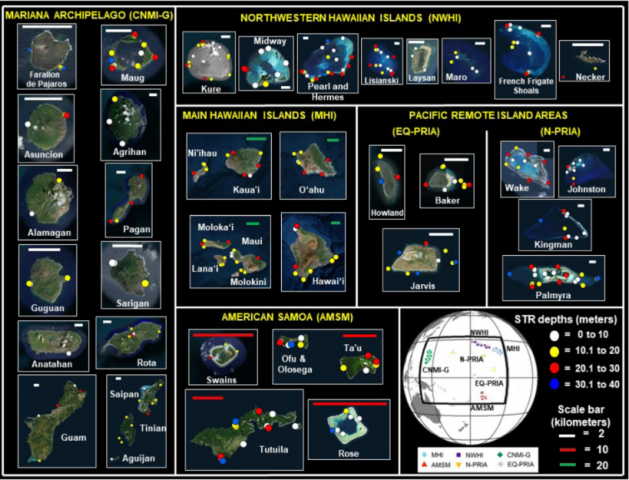
Staff from NOAA Coral Reef Watch (CRW), an initiative supported by the Earth System Science Interdisciplinary Center (ESSIC)-administered Cooperative Institute for Satellite Earth System Studies (CISESS), just co-authored a new publication on heat stressed coral reefs in the Pacific Ocean.
The article, titled “The Rarity of Depth Refugia from Coral Bleaching Heat Stress in the Western and Central Pacific Islands”, was co-written by CRW Coordinator Dr. C. Mark Eakin, ESSIC/CISESS Associate Research Scientist Dr. Gang Liu, and CRW major collaborator Dr. Scott Heron and was published December 23, 2019 in the Nature journal Scientific Reports.
Led by scientists with the NOAA/NMFS Pacific Islands Fisheries Science Center, the paper analyzed 1,453 hot water events at 457 coral reef sites among 49 islands in the western and central Pacific Ocean from 2001-2017. The research team compared at-depth heat stress derived from onsite subsurface temperature recorders with CRW’s version 3.1 daily global 5km satellite coral bleaching Degree Heating Week product.
Results indicated that at most reef sites, corals down to 38 meters depth are just as exposed to marine heatwaves as those in the shallows, and that there was no significant association between depth and subsurface heat stress. What’s more, the study found that heat stress for deep corals estimated by using only CRW’s satellite-based SST and climatology yielded 39.3% lower stress values than subsurface stress measured using loggers.
The study’s two major findings – that there’s no consistent refuge for corals from bleaching-level heat stress at depth in the Pacific, and that scientists are likely underestimating the level of heat stress on their reefs if relying solely on satellite data – highlight the scale of the global problems that climate change poses to coral reef ecosystems and the people trying to study, manage, protect and restore them.
Although these general trends are bad news, the data do reveal a glimpse of a silver lining. Specific sites appear to offer refuge for corals, if the onsite heat stress was less than that measured by satellite data. Knowing where these refuges are located can help coral reef managers to strategize and respond more effectively to major heat stress events on reefs, especially prolonged marine heatwaves.
To access the Scientific Reports publication, click here: “The Rarity of Depth Refugia from Coral Bleaching Heat Stress in the Western and Central Pacific Islands”.
To see a press release issued by NOAA’s National Marine Fisheries Service, click here: “Little Relief in the Deep for Heat-Stressed Corals”.





